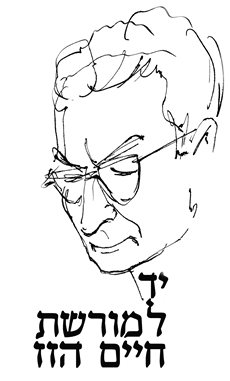“The Hebrew literature should be one of the great literatures among the nations, great in settings and cultures, great in deed and exploit – a reflection of the world entire, as we are dispersed among all lands and nations.” Haim Hazaz
Haim Hazaz was born in 1898, in Russia. In 1921 he emigrated to Turkey, and later moved to Paris. In 1931 he settled in Jerusalem, where he lived and worked until his death in 1973. His works, which were translated into many languages, won him honorary degrees and worldwide fame.
Haim Hazaz’s study offers visitors a glimpse of the creative environment of one of the greatest Hebrew writers of all time. His desk, his library and the other objects in the room were moved to Mishkenot Sha’ananim from the apartment at 18 Hovevey Zion Street, Jerusalem, where Aviva and Haim Hazaz lived.
Haim Hazaz’s library, which is displayed here only in part, comprised some twelve thousand volumes in Hebrew, Russian, French, Yiddish and other languages. Its remarkable composition reveals something of the writer’s rich intellectual world and the sources of his inspiration. Every book is annotated in ways that reflect his thorough and profound reading.
The desk in this room was used by Haim Hazaz in the last two decades of his life, when he composed, among other works, Gates of Bronze (Daltot Nehoshet) and The Gallows (BeKolar Ehad), short stories, the Declaration of the Foundation of Yad Vashem, the Law for the Supreme Institute for the Hebrew Language and the proclamation of the liberation and unification of Jerusalem. Here, at his desk, Hazaz would dictate to his wife Aviva what he had written, and she would type it up.
The letters and manuscripts displayed on the desk reflect the appearance it presented on the day of Hazaz’s sudden death at the height of his extensive literary and public activities as president of the Hebrew Writers’ Association.
All the works of art in the room were presented to Aviva and Haim Hazaz as gifts by the artists Pinchas Litvinovsky, David Handler, Avigdor Stematzky, Joseph Zaritsky and Shimshon Holzman, who formed part of their circle of friends. This circle included other artists, too, such as Yosl and Audrey Bergner, Mordechai Ardon, Menahem Shemi and Aryeh Navon. Many of them painted portraits of Hazaz in which they attempted to decipher his personality.
Haim Hazaz’s study, which was open to the sitting room of the apartment, testifies both to the hospitality that he and his wife extended to all comers and to the important role conviviality and conversation played in his life and work. In this room he hosted not only national leaders, actors, poets, writers, artists and well-known intellectuals but also work-weary laborers and people from all communities, tribes and walks of life – the whole human mosaic that he described so well in his work.
Construction and maintenance of this room was made possible thanks to the generous donation of the late Mrs. Aviva Hazaz (1927-2019), who directed the Haim Hazaz Memorial Foundation and worked tirelessly to preserve her husband’s literary legacy. The room is a joint project of the Jerusalem Foundation, Mishkenot Sha’ananim and the Haim Hazaz Memorial Foundation.
Curator: Dr. Gil Weissblei
Architect: Roi Singer
Designer: Michal Aldor


